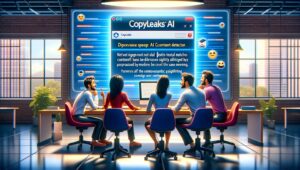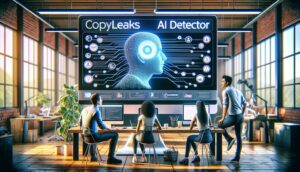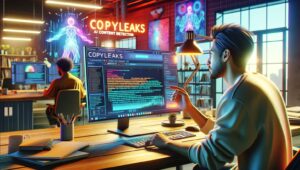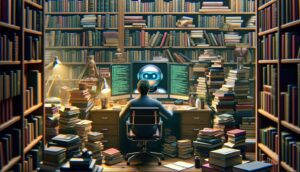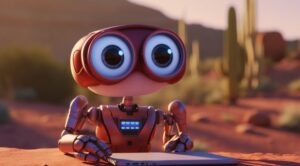Can Copyleaks Detect Chat GPT? Learn how this AI Content Detector separates human from machine-created content.
Have you ever wondered if that super smart essay or article online was written by a person or a clever robot? You’re not alone.
With AI like Chat GPT creating content that seems almost too good to be true, it’s getting hard to tell the difference.
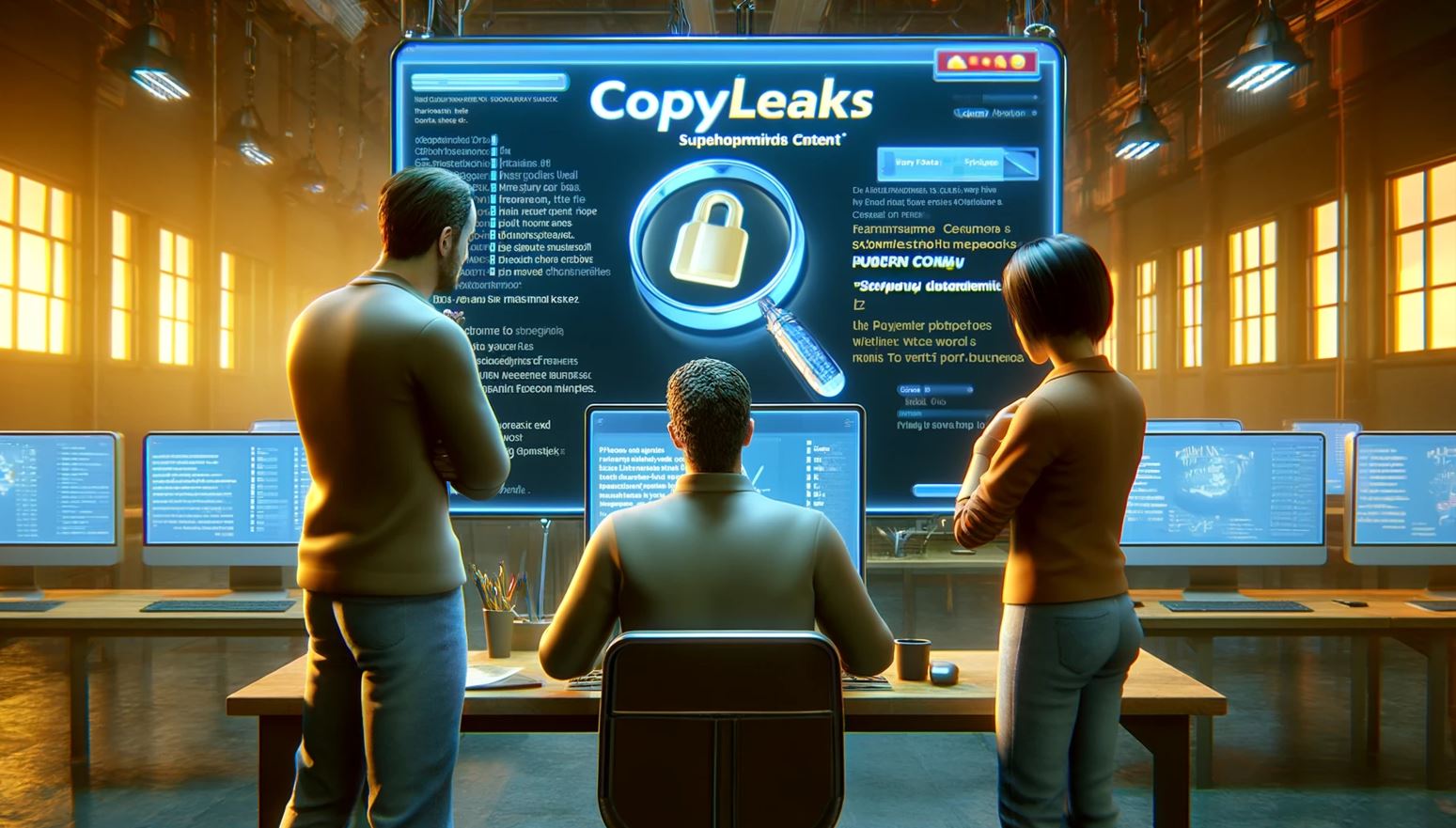
Try these new AI-powered tools:
- 5 Best AI Detectors To Unmask AI-Written Content With Accuracy
- 5 Best AI Writers To Boost Your Productivity And Content Quality.
- This "Secret AI Writer" Can Bypass AI Detection Like A Pro.
Good news: Copyleaks has an AI Content Detector up its sleeve, ready to crack this mystery wide open.
One cool fact about Copyleaks? It can actually spot the difference between something a human typed out on their keyboard and what an advanced text bot like ChatGPT cooked up.
Article At-A-Glance
-
- Copyleaks can definitely spot the difference between human and AI-written text, like what ChatGPT cooks up, so no need to stress about AI sneaking past you.
- With its AI Content Detector, Copyleaks isn’t just pulling a fast one. It nails detecting AI-generated content with over 99% accuracy, which is kind of a big deal.
- Whether it’s essays or articles, Copyleaks has your back, letting you rest easy knowing it’s keeping things 100% real, not letting AI-pulled fast ones get by.
- Just a heads up, while Copyleaks is on point most of the time, it’s not perfect and sometimes, the line between human and AI-written content can get a bit fuzzy.
Table Of Contents
Can Copyleaks Detect Chat GPT?
So, you’re wondering if Copyleaks can spot content made by Chat GPT? The short answer is yes—let’s get into how it does that.
Detection Of Chat GPT And Other AI Writing
Finding out if a piece of writing comes from a person or AI, like ChatGPT, is something Copyleaks does well. It uses special tech to spot differences between human and machine-created texts.
With an impressive hit rate of 99.12%, you can bet it’s on the ball. Whether it’s essays, articles, or code – yes, even the stuff that makes our apps tick – Copyleaks has its ways of telling who did the typing.
This tool isn’t just about catching cheaters though since it helps in areas where knowing the source matters big time.
Think schools making sure work is original, companies keeping their content real, or devs checking their codes are not just copied and pasted from somewhere else.
With AI popping up everywhere these days, having something like Copyleaks keeps everyone playing fair.
Limitations Of Copyleaks AI Content Detector
The Copyleaks AI content detector is smart, but it has its limits. Even with top-notch accuracy, some challenges pop up.
Things like which AI detectors we pick, what kind of content we test on, and when we do these tests all play a big part.
OpenAI threw in their two cents saying detecting Chat GPT can’t always be done with total certainty. But Copyleaks tools have shown they can indeed spot it among the crowd.
Testing showed us that both Chat GPT writing and stuff penned by humans get found out by Copyleaks. Yet, keeping in mind these detection limitations helps us better understand just how effective the tool really is at telling them apart.
Testing showed us that both Chat GPT writing and stuff penned by humans get found out by Copyleaks. Yet, keeping in mind these detection limitations helps us better understand just how effective the tool really is at telling them apart.
This takes us to why finding AI-generated content matters so much in the first place.
Understanding AI Content Detection
Getting why we check if content comes from AI is key. It’s about spotting the difference between what people write and what computers do.
Importance Of Detecting AI-Generated Content
Finding out if content comes from AI, like ChatGPT, is super important. Why? Well, we all want to make sure what we read and learn from is the real deal – made by humans who understand the topic deeply.
AI can whip up some text that seems alright at first glance. But sometimes, it misses the mark because it doesn’t fully get the human touch or common sense behind facts and stories.
Knowing which is which helps keep things fair and honest – especially in schools and for work stuff. Imagine turning in a big project you worked hard on, only to find out someone else just clicked a button to create theirs!
Using tools to spot AI-written texts makes sure everyone plays by the rules, keeping originality and hard work front and center.
Differentiating Between Human-Written And AI Content
Now that we see why spotting AI-generated content matters, let’s chat about telling it apart from what humans write. It might sound like a tough job, but some tools and tricks can help.
For starters, AI writing detection looks for patterns that are not common in human writing. This could be how words are put together or the kind of mistakes made.
Humans tend to have a unique style – like using slang or making typical errors. On the other hand, AI might not catch these nuances.
Even though tools are getting better at catching AI-written text, there’s still a tiny chance they’ll mess up and flag human work by mistake (about 0.2%).
So, while we’re moving forward with technology to spot these differences, it’s good to keep an eye on where it shines and where it might trip up.
Copyleaks AI Content Detector
Copyleaks AI Content Detector is like a super-sleuth for text. It peeks into words to find out if they’re written by people or clever bots like Chat GPT.
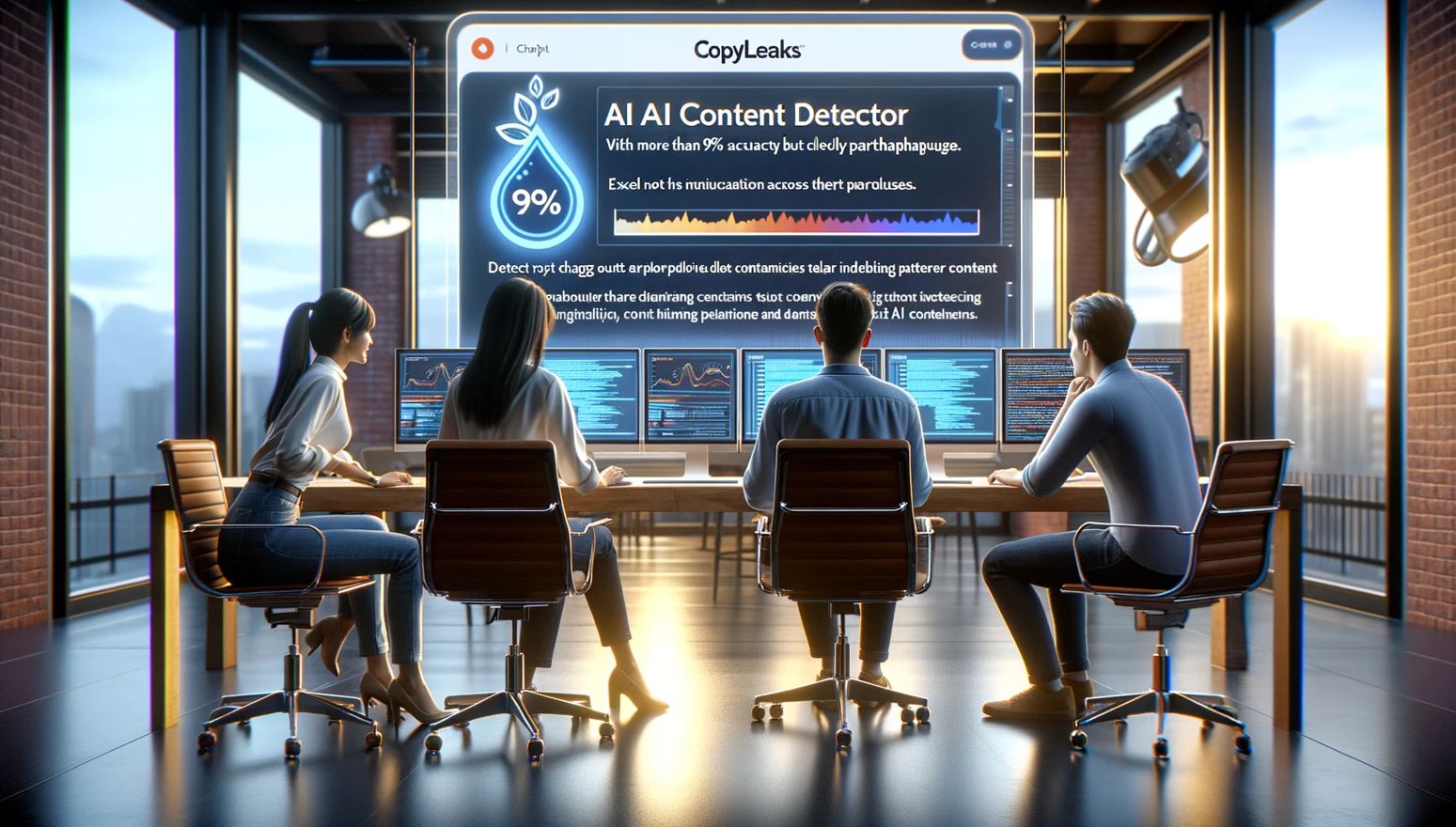
Nearly A Decade Of Development
For nearly ten years, the minds behind Copyleaks AI Content Detector have been hard at work. They’ve spent countless hours tweaking and improving their system. The goal? To spot AI-written text like ChatGPT creates.
This isn’t a small feat, considering how smart these AI tools can be. Over this time, they crafted a tool that doesn’t just guess if content came from a computer brain. It knows—with over 99% accuracy across more than thirty languages.
This long-term effort paid off big time. The technology scooped up awards and earned high praise from users around the globe. Think of it as language detection on steroids—able to pinpoint where text comes from, whether human or machine.
Sure, OpenAI threw down the gauntlet by saying detecting tools might not always catch ChatGPT in action. Yet here stands Copyleaks, proving them wrong with its advanced tech hands down!
Award-Winning Technology
Copyleaks AI Content Detector shines as an award-winning technology. It’s been grabbing awards for its cutting-edge ability to spot AI-generated content with over 99% accuracy.
This tool has mastered text pattern recognition, making it a star in detecting not just ChatGPT but all advanced AI models out there.
This technology packs a punch with its accurate detection across 100 languages. Whether it’s uncovering plagiarism or spotting paraphrased content sneaking through, Copyleaks does it all without breaking a sweat.
Plus, it can even catch AI-generated source code, showing how versatile and powerful this tool really is.
Key Features
So, you’re curious about what makes Copyleaks stand out? Well, it’s all about hitting the bullseye with speed and nailing accuracy when catching AI-written content.
Their toolkit isn’t just fast—it’s similar to lightning, spotting not only those tricky bits of copied work but also sniffing out if a clever bot has been doing someone’s homework.
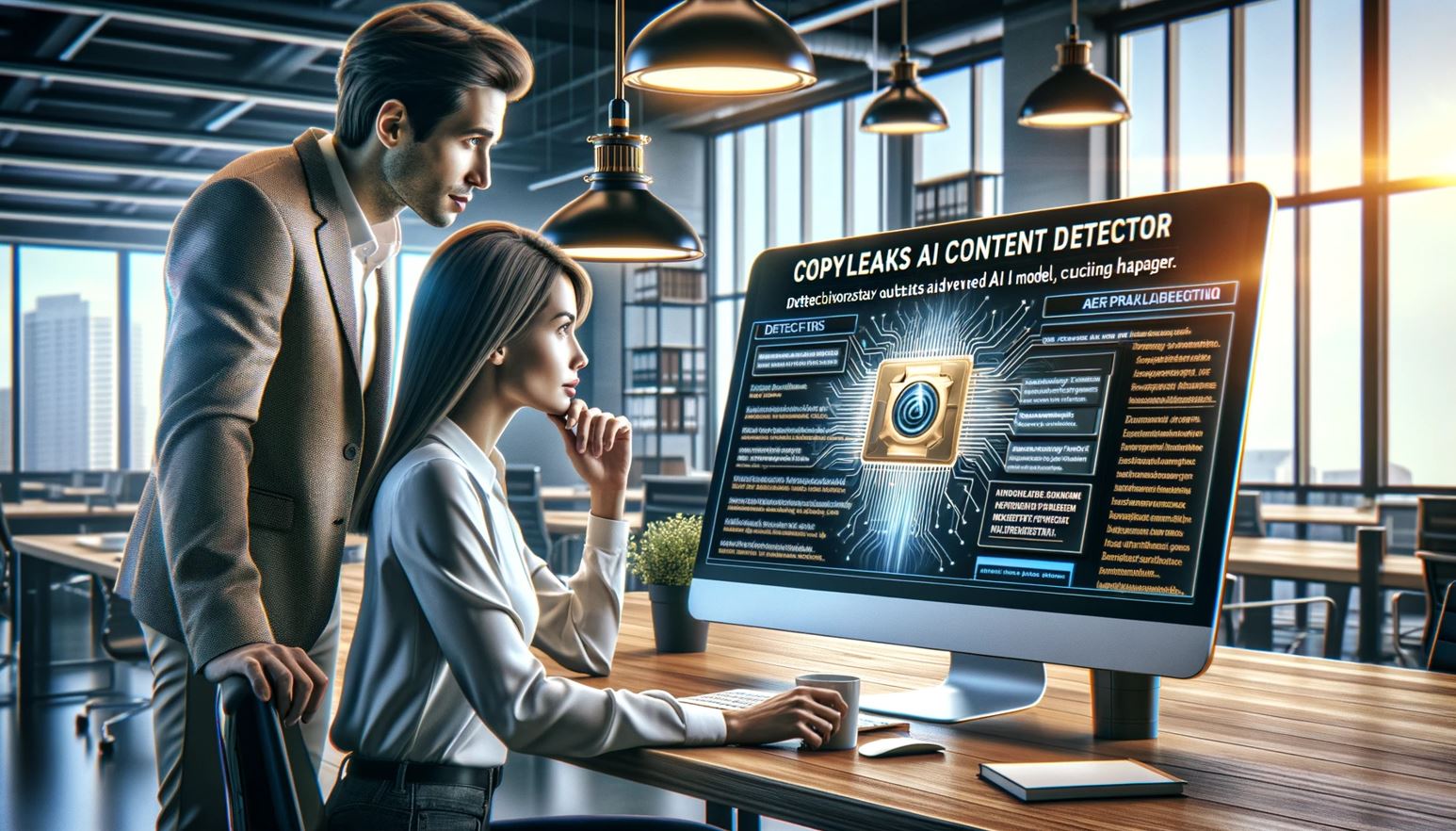
Complete AI Model Coverage
Copyleaks shines with its ability to cover all AI models out there. Yes, you heard that right! It has a special way of spotting if something was written by humans or by ChatGPT and its friends like GPT-3.5 and GPT-4.
This tool is super smart, catching new AI models the moment they pop up on the scene. Think of it as having an eagle eye for anything AI writes, ensuring nothing sneaky gets past.
Now, imagine this power in your hands: accuracy hitting 99.1% based on tests from smart folks not part of Copyleaks. This means almost every time AI tries to sound human, Copyleaks can call its bluff.
We’re talking about magic-level detection here – identifying language models without breaking a sweat.
Next up? Let’s look into how fast and sharp this tool really is.
Unprecedented Speed And Accuracy
Moving from the wide range of AI models Copyleaks covers, let’s zoom into something equally impressive: its speed and accuracy. This tool shines with exceptional swiftness and unmatched precision.
Imagine getting results in just a blink. Yep, that’s what we’re talking about here. The tech behind this? Well, it’s pretty much top-notch, boasting an overall accuracy rate of 99.1%.
And if you’re worried about those pesky false positives—don’t be. They barely make a dent at a rate of just 0.2%.
So, you get your paper back faster than you could grab a coffee—and with outstanding precision to boot! This isn’t just fast. It’s lightning-fast, combined with superior accuracy that ensures nothing slips through the cracks.
Whether it’s catching those cleverly paraphrased bits or spotting AI-generated text trying to sneak past as human work, this detector does not miss a beat.
Think of it as the superhero of content detection—always on guard and ready to swoop in at unprecedented quickness and reliability.
Plagiarism And Paraphrased Content Detection
Copyleaks can spot the sneaky stuff – like when someone tries to pass off copied work as their own or switches a few words around to make it look new.
It’s pretty sharp at catching direct plagiarism, finding those bits that are too close for comfort, and checking if content is the real deal.
Think of it as having super-vision for seeing through the tricks in written work.
This means it can tell you if someone did a copy-and-paste job or got clever with paraphrasing, making sure nothing slips past unnoticed.
With its high-tech tools, Copyleaks doesn’t just give a thumbs up or down on originality. It goes deep. This means it can tell you if someone did a copy-and-paste job or got clever with paraphrasing, making sure nothing slips past unnoticed.
So yeah, whether it’s an essay that seems a bit too polished or an article echoing something you’ve read before, this tool has your back in keeping things honest and authentic.
Detection Of AI-Generated Source Code
Detecting AI-generated source code is a real game changer. Imagine having superpowers in the digital world. The Copyleaks AI Content Detector can spot AI-made code right down to its function.
Imagine that! You’ve got a tool that goes deep, making sure no sneaky, robot-written lines of code pass as human-created.
Plus, with impressive accuracy rates boasted by some tools—hello, more than 95%—it’s clear we’re playing in the major leagues.
Now think about how this shakes up things for anyone writing or checking software. A detector that swiftly catches if a piece of code was crafted by a machine or a person? That’s not just cool. It’s essential in keeping our digital creations honest and original.
With billions of online sources at its fingertips for plagiarism checks, this technology doesn’t just spot copycats—it unveils the true nature behind those mysterious strings of codes.
Use Cases For The AI Content Detector
Explore how the AI Content Detector shines in different fields, pushing for honesty in writing and coding alike. Get ready to see its power in many places, from schools to big companies!
AI Model Training
Training AI models, like the one Copyleaks uses, involves feeding them lots and lots of text. This helps them learn to spot differences between words a human would pick and ones an AI might come up with.
Since 2015, folks at Copyleaks have been working hard to make their system smarter at recognizing these patterns. They use tricks from machine learning and NLP (that’s short for Natural Language Processing) to get better and better.
They didn’t stop there. These clever individuals also made sure their tool could tell if something was written by ChatGPT or another bot.
Imagine teaching your dog to fetch. It’s kind of like that but with computers — lots of practice, treats (in this case, data), and patience!
The study shows nearly 60% of ChatGPT texts can be caught. Yeah, that’s the kind of success they’re after.
Academic Integrity
Academic integrity is a big deal. It’s all about being honest and fair in schools and colleges. This means no cheating or using someone else’s work as your own. With tools like Copyleaks, detecting AI-written essays or projects becomes easier.
These tools help tell if a student did the work themselves or if they got a machine to do it for them.
Sometimes, though, these detectors might not be perfect. They could think someone cheated when they didn’t, which isn’t fair either.
So while these tools are super useful in keeping things honest, we have to use them carefully to make sure everyone gets treated right.
Next up: let’s talk about governance and how all of this plays into keeping rules fair and square.
Governance
Moving from academic integrity to the broader picture, governance steps onto the stage with a significant role. It’s all about setting rules and making sure everyone follows them, especially when dealing with generative AI technologies.
Think of it as making sure nobody’s stepping out of line in using these advanced tools.
Companies now have a nifty way to keep an eye on things. They can monitor how these AI models are used across their operations. If needed, they can even say “no more” to storing chat histories or tweak other settings.
It’s kind of like having a remote control for managing how this tech plays out companywide—ensuring everything is up to snuff with policies and compliance isn’t just smart. It’s necessary.
Publishing And Copywriting
Publishing and copywriting are all about making words work hard. With Copyleaks AI Content Detector, we see a cool way to check if the words are from a human or an AI like ChatGPT.
Now, think of how this shakes things up in publishing. You want your stories to feel real and grab hearts. But if you’re not sure who—or what—wrote something, it gets tricky.
For folks writing ads or web content, knowing if a text is AI-generated matters too. They aim for genuine connections with readers. Using tools that spot AI-written stuff helps keep things authentic.
This tech also makes sure copywriters stay sharp and creative, beating out any robot-written competition.
Copyleaks Is What You Need To Detect ChatGPT
So, can Copyleaks catch Chat GPT in the act? Yep, it sure can. This tool is like a detective for text, finding out if words are from a human or a clever bot.
It’s fast and smart, catching not just copied stuff but also when someone tries to hide it by changing words around.
And guess what? It works on code too! Whether you’re making an AI smarter, keeping schools honest, running a government, or writing for the world to see – this gadget has your back.
So go ahead. Give it a spin and stay true to real words.
Meet our resident tech wizard, Steve the AI Guy. Now, before you get any wild ideas, let’s clear up one thing – he’s 100% human! I mean, he’s got the work history to prove it. He spent a decade diving into the deep end of the tech industry doing business intelligence work, splashing around with two of the world’s largest business consulting companies, Deloitte and Ernst & Young. Learn More



